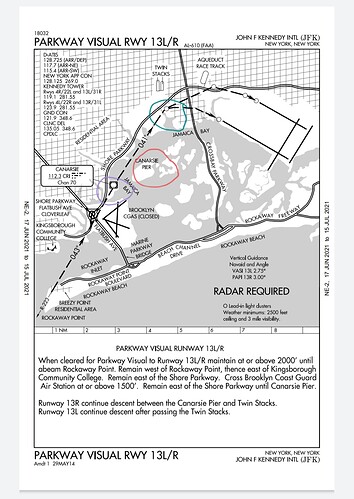Introduction
We’ve all heard of JFK. Probably the most well-known airport in the world along with LAX and LHR. Many people wouldn’t think that a major international airport has difficult approaches and turns. However, JFK does have an interesting approach to two of its runways - the Canarsie Visual Approach. It involves a steep turn (especially 13R) on final, at an altitude of barely 800 feet above ground level. The question is, why would such an airport have this challenging approach, when there is no high terrain obstructing the final approach path? Also, there happens to be an ILS for 13L, so why not bother to use the good old 15-20nm straight in approach? I will cover this in detail later on.
History
There are three airports very close to each other in the area (KJFK, John F Kennedy; KLGA, La Guardia; KEWR, Newark Liberty.) A straight in approach to 13L using the ILS wouldn’t make sense as it will intersect the LGA airspace, making insufficient separation a problem. That’s why, in the 1970s, the Canarsie Visual was ‘invented’, requiring pilots to come in from the south west, overflying the Canarsie VOR and turning to either 13L or R on short final.
Flying Guide
Here comes the real part: the flying. This handy and easy-to-read chart for the approach is essential for a successful landing. I will explain every part of it to make things clear though!
Now you can see that I circled three points on the chart: the VOR, Canarsie Pier and just south of the Twin Stacks. Those are the most important parts of the approach, which I will explain here.
- It says at the bottom, when cleared for approach, maintain 2000ft or above before reaching Rockaway Point which is quite easy to identify since it is the southernmost tip of the Queens borough that you are going to fly past on approach to JFK.
- Remain east of Kingsborough Community College which is in Brooklyn. Don’t worry if it is not modeled in the flight simulator because it is directly opposite to Rockaway Point, across the water. Maintain an inbound radial of 043 all the way until Canarsie VOR.
Edit: R-223 is the outbound radial, when tracking outbound from Canarsie which is not the case for this approach.
- Fly past Brooklyn Coast Guard Air Station which is just south of the VOR at 1500’ or above. It is also east of where Marine Parkway bridge and Shore Parkway (the long winding road besides the shore) meet, so it is also not too hard to identify. You should be flying east of the Shore Parkway.
Here is where it gets a bit complicated:
- After crossing the CRI VOR, there is a small island to the east straight ahead (Canarsie Pier, which I circled in red). A heading of 041 should be flown from this point until Jamaica Bay. If you are landing runway 13R you should start your descent between the pier and Twin Stacks (near Jamaica Bay). Maintain altitude if you are heading for 13L.
- Abeam Twin Stacks (circled in red) (which you can use Jamaica Bay as a landmark, the bay when the landscape starts to turn towards the east) you should do the following for each runway:
a) 13R. You should have already commenced the descent by now, so just align your plane with the runway, continue descending and land.
b) 13L. Start your descent, and turn slightly in the direction of the Crossbay Parkway and Shore Parkway intersection, however stay slightly south of where the roads meet, until the Aqueduct Race Track (you can take the first part of the Shore Parkway east of the intersection as a landmark.) After that, align with the runway, keep descending and land.
Remarks
When winds are from the east 13L is mostly used for landing and 13R for take-off. However during less busy hours DL and other airlines that use T1/2/4 prefer to use 13R for landing (if ATC allows that) because of reduced taxi times. Also the weather minimums for the Canarsie Visual are 3sm visibility and 2500’ ceiling, so if weather conditions do not meet requirements do not attempt the approach.
Overall it is a fun and challenging approach, I definitely recommend you to try it out!
I hope you found this useful and thanks for reading!
P. S. I didn’t make a full airport tutorial intentionally because I want each topic to be as focused on its specific purpose as possible.
Bye
